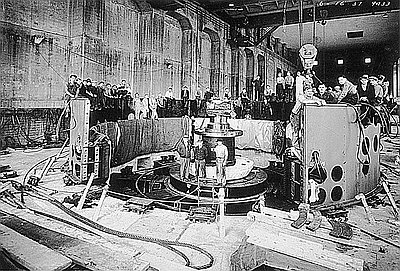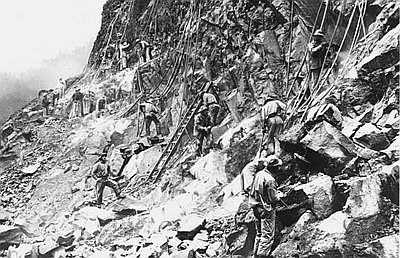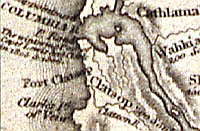The Electric Century: The Promise of Technology
The Lewis and Clark Exposition at night was a blaze of light. One hundred thousand electric bulbs lit the walkways and outlined the buildings. The fair glowed in the night sky and glistened in its lake. The nineteenth century had marked the triumph of steam power and its capacity to reshape the landscape. The new century promised to be the era of electricity.
In the short term, it was no coincidence that the Exposition company president, Henry W. Goode, was also the president of the Portland Railway, Light, and Power Company—the future Portland General Electric. The company had been created a few years earlier through the merger of several electric streetcar companies. At the time of the fair, it was evolving from a trolley company that manufactured its own electric power from dams on the Clackamas River to a power company that made most of its money marketing kilowatts.
In each generation after the Exposition, Americans came to expect more and more daily assistance from electricity. First were a few electric lights to take place of dangerous kerosene lamps and gas lights. Then toasters and radios and vacuum cleaners; refrigerators to take place of iceboxes in the 1930s and 1940s; washing machines to take place of scrub boards; televisions, clothes dryers, dishwashers, sound systems, computers.
In Oregon, electricity also promised an economic breakthrough. Hydroelectric power, said its advocates, could complete the modernization of rural life that had been started by irrigation, turning dry desert lands into “pastures of plenty” as Woody Guthrie wrote in his famous song. Brought to Oregon in 1941 by the Bonneville Power Administration to publicize the new dam between Portland and Cascade Locks, Guthrie penned a whole notebook full of songs. There were “Pastures of Plenty,” “Roll On, Columbia,” and less well known pieces like “Mile An’ a Half from th’ End of th’ Line,” in which a farmer living off the power grid laments that life is tough trying to read the Bible by a coal oil lamp:
Oregon state is mighty fine,
If you're hooked on to the power line.
But there ain’t no country extry fine,
If you're just a mile from the end of the line.
Hydropower held the promise to promote manufacturing. Oregon could turn its raw materials into high value products at home rather than shipping them out of state and buying them back as finished products at much higher prices. Hopes centered on Bonneville Dam in the 1930s. Port of Portland Commissioner John H. Lewis put the situation simply: “that city of the Northwest which first captures and uses the greatest amount of Columbia River power, will be the largest city. The fight for industrial supremacy will be over when all the Columbia River power is distributed.” Fighting against Seattle’s claims on Bonneville power, the Portland Chamber of Commerce vigorously argued that its electricity was a local commodity that should not be burdened with the cost of extensive transmission lines.
What Portland offered during the dam-building era of the mid-twentieth century was a vision of industrial development at the gateways to the Columbia River Gorge—at the head of navigation at The Dalles and along the Columbia River near Portland. A confidential report to Interior Secretary Harold Ickes, for example, reported that the Oregon Commonwealth Federation “agreed that industry should not be located in the Columbia Gorge, but that if it came in, it should locate between Camas [Washington] and Rainier [Oregon].” Portlanders pointed out the abundance of industrial sites on the North Portland peninsula. Lower power rates along the entire lower Columbia River, said the Portland City Club of Portland, would benefit Portland’s economy while raising “no danger of marring the scenic or recreational features of the Columbia Gorge by the location of industrial plants.” The Oregon State Planning Board, Mayor Joseph Carson, and even Portland’s electric utilities all found themselves in basic agreement with urbanist Lewis Mumford, who specifically suggested that the new electricity be used to build a greenbelt town where the Gorge widens out at its west end near the Sandy River.
The results of industrial development after 1940 confirmed the Portland agenda. The new wartime aluminum plants that were by far the largest industrial offspring of Bonneville Dam were located just outside the Gorge at Troutdale, Oregon, and Vancouver, Washington, and downstream at Longview, Washington. Later industrial development at The Dalles after the construction of The Dalles Damwould again take place outside the scenic zone.
By the beginning of the twenty-first century, Oregonians drew hydropower from dams on the Deschutes River, the tributaries of the Willamette, and especially the Columbia and Snake rivers. The generating capacity of Bonneville Dam was overshadowed by The Dalles Dam, McNary Dam, and especially Grand Coulee Dam.
The “electric industry” went through big changes in the second half of the twentieth century. Hydroelectric power in the 1940s and 1950s, for example, had created an instant aluminum industry along the Columbia River whose output helped to win World War II and feed postwar consumerism. By the 1990s, the aluminum business was fading, while growth in Oregon manufacturing centered on the high technology complex of computers, electronic and electrical machinery, instruments, and computer services.
In effect, the state’s economic drive wheel transitioned from electricity to electronics. These industrial categories accounted for roughly 70,000 Portland area workers at the height of the boom in the late 1990s, roughly double the number a decade earlier. The two largest firms in 1998 were Intel and Tektronix, both of which functioned as centers of innovation and seed beds for new, specialized high tech firms. The state’s other electronics cluster, with more than 10,000 employees, was Corvallis-Albany. Statewide, high tech employment passed timber-related employment in the mid-1990s.
The high tech industry shows a marked pattern of concentration. The more sophisticated technology firms are concentrated in Washington County, creating an industrial district that boosters dubbed the “Silicon Forest” in the 1980s. Silicon wafer and semiconductor plants are more widely scattered in Portland, Gresham, and Clark County. In contrast, software and multimedia firms cluster in central Portland, in proximity to advertising, publishing, art galleries, and financial services.
Telecommunications scholar Mitchell Moss used the registered location of commercial Internet domains (.com addresses) at the end of the 1990s to assess the relative standing of eighty-five cities as Internet information centers. Portland’s location quotient of 3.11 placed it a satisfying sixteenth, several steps up from earlier in the decade. Another comparison by the Progressive Policy Institute in 2001 placed Portland thirteenth among fifty large metropolitan areas in its engagement with the “digital economy.” The development of digital and information businesses helped to transform the northern fringe of downtown Portland into a district of expensive converted loft apartments, new upscale condominiums, and stylish restaurants. This “Pearl District” can be viewed as a small-scale version of the South of Market district in San Francisco.
© Carl Abbott, 2004. Updated and revised by OHP staff, 2014.
Sections
Related Historical Records
Exposition Company Leaders
This image, showing the directors and officers of the 1905 Lewis and Clark Exposition, is from the fair’s “Portland Day” program. The officers were mostly local businessmen, who …

Bonneville Dam Workers Assembling Turbine
In 1937, the U.S. Army Corps of Engineers (USACE) completed construction of Bonneville Dam, located forty-two miles east of Portland on the Columbia River. The dam’s turbines, connected …

Workers at Bonneville Dam Site, 1935
This 1935 photograph shows workers excavating volcanic rock at the construction site of Bonneville Dam on the Columbia River. Workers used jackhammers and explosives to remove rock in …




